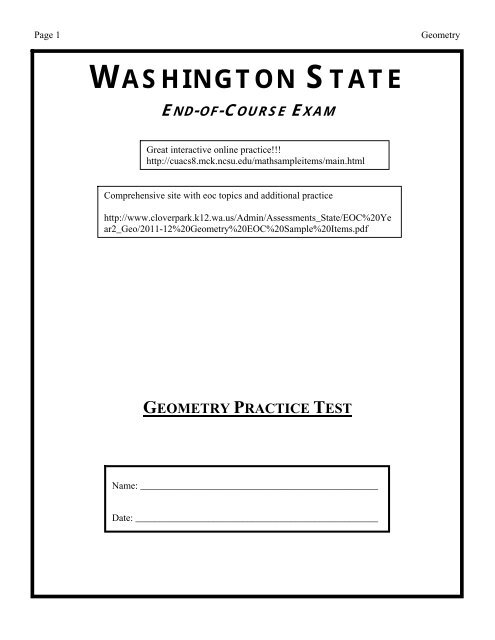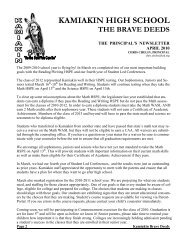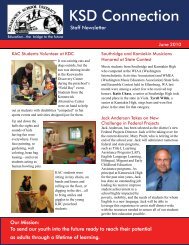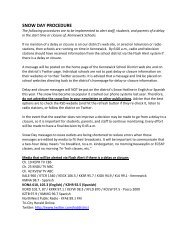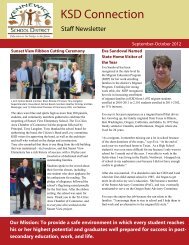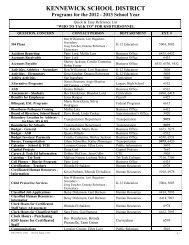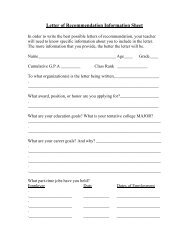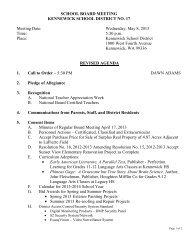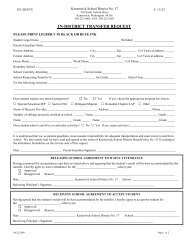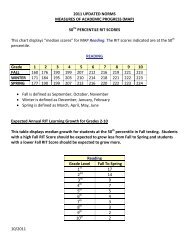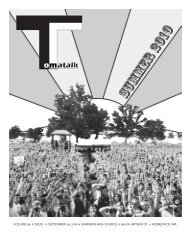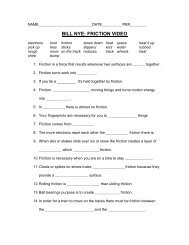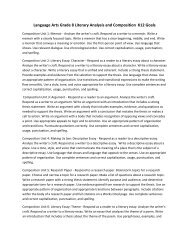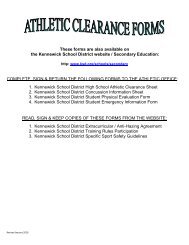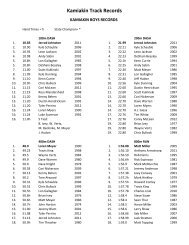EOC MOC Geometry Exam
EOC MOC Geometry Exam
EOC MOC Geometry Exam
Create successful ePaper yourself
Turn your PDF publications into a flip-book with our unique Google optimized e-Paper software.
Page 1<br />
<strong>Geometry</strong><br />
WASHINGTON STATE<br />
END-OF-COURSE EXAM<br />
Great interactive online practice!!!<br />
http://cuacs8.mck.ncsu.edu/mathsampleitems/main.html<br />
Comprehensive site with eoc topics and additional practice<br />
http://www.cloverpark.k12.wa.us/Admin/Assessments_State/<strong>EOC</strong>%20Ye<br />
ar2_Geo/2011-12%20<strong>Geometry</strong>%20<strong>EOC</strong>%20Sample%20Items.pdf<br />
GEOMETRY PRACTICE TEST<br />
Name: _________________________________________________<br />
Date: __________________________________________________
Page 2<br />
<strong>Geometry</strong><br />
GENERAL DIRECTIONS<br />
Today you will be taking a Washington State <strong>Geometry</strong> End-of-Course Practice Test. To<br />
complete this test, you will need to use the answer document provided with this practice<br />
test on page 22. This practice test is designed to simulate the Washington State <strong>Geometry</strong><br />
testing experience.<br />
Three different types of questions appear on this test:<br />
While taking this test, remember:
Page 3<br />
<strong>Geometry</strong><br />
1. Read each question carefully, including diagrams and graphs.<br />
2. For multiple-choice questions, choose the best answer from the four choices given.<br />
Mark only one response for each multiple-choice question.<br />
3. For short-answer questions, write your answers in the box provided. You do not<br />
have to use all of the space provided. Answers may be graphs, text, or calculations.<br />
4.If a short-answer question asks you to show your work, you must do so to receive<br />
full credit. If you are using a calculator, describe the calculation process you used in<br />
enough detail to be duplicated, including the numbers you entered and the function<br />
keys you pressed to find the answer. If a short-answer item has multiple parts, label<br />
each section of work and clearly identify your answer for each part.<br />
A formula sheet is provided for the <strong>Geometry</strong> End-of-Course <strong>Exam</strong>, and is provided on<br />
Page 20 and 21 of this Practice Test.<br />
The Practice Test will be broken up into 3 different sections and will be completed in one<br />
sitting that will last approximately 150 minutes (there is no time limit):<br />
Section 1: Questions 1-6<br />
* Logical arguments and proof<br />
Section 2: Questions 7-29<br />
* Proving and applying properties of 2-dimensional figures<br />
Section 3: Questions 30-37<br />
* Figures in a coordinate plane and measurement<br />
* Be sure to answer all questions before you end each test session. However, do not<br />
spend too much time on any one question.<br />
* If you do not know the answer to a question, make your best guess and go on to the next<br />
question.<br />
* You will not be penalized for guessing.<br />
GEOMETRY END-OF-COURSE EXAM: PRACTICE TEST
Page 4<br />
<strong>Geometry</strong><br />
1. Seth was supposed to prove ABC PQR by SAS for his homework assignment. He<br />
wrote the following proof:<br />
Given ABC PRQ, AB PQ, and BC QR, then ABC PQR by SAS.<br />
Which statement should be changed in order for Seth’s proof to be correct?<br />
a. ABC PRQ should be rewritten as ABC PQR.<br />
b. AB PQ should be rewritten as AB PR .<br />
c. BC QR should be rewritten as AC QR.<br />
d. ABC PQR by SAS should be rewritten as ABC PQR by SSA.<br />
2. Which of the following best describes a counterexample to the assertion below:<br />
Two lines in a plane always intersect in exactly one point.<br />
a. Coplanar Lines<br />
b. Intersecting Lines<br />
c. Parallel Lines<br />
d. Perpendicular Lines<br />
3. Which of the following statements is true:<br />
a. A postulate is a proven fact using theorems, definitions, and undefined terms.<br />
b. A theorem is a proven fact using postulates, definitions, and undefined terms.<br />
c. Some defined geometric terms are line, plane, and point.<br />
d. Some undefined geometry terms are angle, ray, and line segment.<br />
4. Given: CBF CDG, AC bisects BAD.<br />
Prove: AD AB
Page 5<br />
<strong>Geometry</strong><br />
5. If an indirect proof is used to prove the following theorem, then which assumption must be<br />
proved false?
Page 6<br />
<strong>Geometry</strong><br />
If two lines form a pair of congruent corresponding angles, then the lines are<br />
parallel.<br />
a. The corresponding angles are congruent.<br />
b. The corresponding angles are not congruent.<br />
c. The lines intersect.<br />
d. The lines do not intersect.<br />
6. Given the statement:<br />
Conditional: If the table top is rectangular, then its diagonals are congruent.<br />
The inverse of the conditional statement is:<br />
Inverse: If the diagonals of a table top are congruent, then it is rectangular.<br />
Identify by writing yes/no on the first line below if the statement above has correctly<br />
identified the inverse of the conditional. If the inverse above is incorrect, correctly write it<br />
in the space below.<br />
Inverse of Conditional<br />
________________________________________________________________________<br />
________________________________________________________________________<br />
________________________________________________________________________<br />
________________________________________________________________________<br />
________________________________________________________________________<br />
________________________________________________________________________<br />
________________________________________________________________________<br />
________________________________________________________________________
Page 7<br />
<strong>Geometry</strong><br />
7. What is the name of the point of concurrency where the three angle bisectors of a triangle<br />
meet?<br />
a. Circumcenter<br />
b. Incenter<br />
c. Centroid<br />
d. Orthocenter<br />
8. Given that ABC DEC and mE 23, find mACB .<br />
a. mACB 77<br />
b. mACB 67<br />
c. mACB 23<br />
d. mACB 113<br />
9. Triangle JKE is an obtuse isosceles triangle with mE 10 and KE > JK.<br />
What is the measure of mJ ?<br />
a. 170<br />
b. 160<br />
c. 85<br />
d. 10
Page 8<br />
<strong>Geometry</strong><br />
10. In the diagram:<br />
AB EB<br />
ADB ECB<br />
Prove ABD EBC using mathematical language and concepts.
Page 9<br />
<strong>Geometry</strong><br />
11. Choose the true statement based on knowing point O is the orthocenter of triangle ABC.<br />
a. BDACDA<br />
b. BOCO<br />
c. BADCAD<br />
d. EO FO<br />
12. Which triangles are congruent in the diagram?<br />
a. HMN HGN<br />
b. HMN NGH<br />
c. NMH NGH<br />
d. MNH HGN
Page 10<br />
<strong>Geometry</strong><br />
13. Find the length of side TV.<br />
a. 11<br />
b. 11 2<br />
c. 11 3<br />
d. 22<br />
14. A tree casts a shadow that is 150 feet long. If the angle of elevation from the tip of the<br />
shadow to the top of the tree is<br />
30°, how tall is the tree to the<br />
nearest foot?<br />
a. 87 feet<br />
b. 106 feet<br />
c. 212 feet<br />
d. 259 feet
Page 11<br />
<strong>Geometry</strong><br />
15. A rectangular prism is shown. The base of the prism is a square. The length of the diagonal<br />
from top corner A to opposite bottom corner B is 2 feet.<br />
Determine the exact length of the box in inches.<br />
Write your answer on the line.<br />
What is the exact length of the box? _______________ inches<br />
16. Which side lengths represent the sides of a right triangle?<br />
a. 1, 1, 2<br />
b. 2, 3, 5<br />
c. 5, 12, 13<br />
d. 7, 23, 25
Page 12<br />
<strong>Geometry</strong><br />
17. Use the trigonometric ratio sin A 0.38 to<br />
determine which angle of the triangle is A.<br />
a. 2<br />
b. 1<br />
c. 3<br />
d. No Solution<br />
18. Find the value of y.<br />
a. y 5sin28<br />
b. y 5cos28<br />
c. y 5cos62<br />
d. y 5sin62<br />
19. At takeoff, a plane flies at an angle of 10° with the runway. After it has traveled a ground<br />
distance of 2,800 feet, find the vertical distance the plane has gained from takeoff. Round<br />
your answer to the nearest foot.<br />
a. 486 feet<br />
b. 494 feet<br />
c. 2,757 feet<br />
d. 15,880 feet<br />
20. In parallelogram PQRS the measures of angle P and angle R are each 146. What is the<br />
measure of angle Q?<br />
a. 146<br />
b. 112<br />
c. 68<br />
d. 34
Page 13<br />
<strong>Geometry</strong><br />
21. Which statement can you use to conclude that quadrilateral XYZW is a parallelogram?<br />
a. XW YZ and XY WZ<br />
b. XW WZ and XY WZ<br />
c. YN NX and XN NY<br />
d. XW YZ and XY YZ<br />
22. Which description does NOT guarantee that a quadrilateral is a parallelogram?<br />
a. A quadrilateral with both pairs of opposite sides congruent.<br />
b. A quadrilateral with the diagonals bisecting each other.<br />
c. A quadrilateral with consecutive angles supplementary.<br />
d. Quadrilateral with two opposite sides parallel.<br />
23. In the following polygon, determine the value of x.<br />
a. 78<br />
b. 81<br />
c. 95<br />
d. 99<br />
24. One exterior angle of a regular polygon measures 97°. What is the measure of one interior<br />
angle?<br />
a. 7<br />
b. 83<br />
c. 173<br />
d. 263
Page 14<br />
<strong>Geometry</strong><br />
25. What is the missing reason for the proof?<br />
Given: Parallelogram ABCD with diagonal BD<br />
Prove: ABD CDB<br />
a. Reflexive Property of Congruence<br />
b. ASA<br />
c. Alternative Interior Angles Theorem<br />
d. SSS<br />
26. In the accompanying diagram of rectangle ABCD, m∠ABE = 30 and m∠CFE = 144. Find<br />
m∠BEF.<br />
a. 36°<br />
b. 60°<br />
c. 84°<br />
d. 90°<br />
27. In trapezoid DEFG, find mD.
Page 15<br />
<strong>Geometry</strong><br />
a. 44<br />
b. 72<br />
c. 108<br />
d. 136<br />
28. Which of the following statements is always true of any rhombus ABCD?<br />
a. A B<br />
b. ABBC<br />
c. AC BD<br />
d. ACBD<br />
29. In kite DEFC, if mDCF 20 and mDEF 80, find<br />
mCDE .<br />
Write your answer on the line below<br />
mCDE = _____________________________________________
Page 16<br />
<strong>Geometry</strong><br />
30. The vertices of a square are (3, 1), (-2, 0), (-1, -5), and (4, -4). The diagonals of the square<br />
intersect at point Q.<br />
Determine the coordinates of point Q.<br />
You may use the blank grid to help determine the solution.<br />
Write your answer on the line.<br />
What are the coordinates of point Q? ( ______, ______ )<br />
31. Isosceles triangle ABC has vertices at A(0, 0), B(8, 0), and C(x, 12).<br />
The value of x could be:<br />
a. 4<br />
b. 8<br />
c. 12<br />
d. 16
Page 17<br />
<strong>Geometry</strong><br />
32. What is the most precise name for a quadrilateral with vertices (-4, -1), (1, -1), (4, 3), and<br />
(-1, 3)?<br />
a. Kite<br />
b. Parallelogram<br />
c. Trapezoid<br />
d. Rhombus<br />
33. The U.S. Census Bureau reported a national population of 299,894,924 on its Population<br />
Clock in mid-October of 2006. One can say that the U.S. population is 3 hundred million<br />
(3 x 10 8 ) and be precise to one digit. Although the population had surpassed 3 hundred<br />
million by the end of that month explain why 3 x 10 8 remained precise to one digit.<br />
________________________________________________________________________<br />
________________________________________________________________________<br />
________________________________________________________________________<br />
________________________________________________________________________<br />
________________________________________________________________________<br />
________________________________________________________________________<br />
________________________________________________________________________<br />
________________________________________________________________________<br />
________________________________________________________________________<br />
________________________________________________________________________<br />
________________________________________________________________________<br />
________________________________________________________________________<br />
________________________________________________________________________<br />
________________________________________________________________________<br />
________________________________________________________________________<br />
________________________________________________________________________
Page 18<br />
<strong>Geometry</strong><br />
34. What is the best estimate for the surface area of the prism?<br />
a. 34 ft 2<br />
b. 48 ft 2<br />
c. 72 ft 2<br />
d. 96 ft 2<br />
35. Convert 20 miles/hour to meters/second (round to the nearest meter).<br />
1 mile = 5,280 feet<br />
1 foot = .3048 meters<br />
Write your answer on the line below.<br />
20 miles/hour = ______________ meters/second
Page 19<br />
<strong>Geometry</strong><br />
36. There are 5 horses on 12 acres of land. What is the mean number of square yards per horse?<br />
1 acre = 43,560 square feet<br />
a. 8,712 square yards<br />
b. 11,616 square yards<br />
c. 34,848 square yards<br />
d. 58,080 square yards<br />
37. On a coordinate grid, a grocery store is located at (3,0) and the hardware store is located at<br />
(4,3). If the hardware store is the midpoint between the grocery store and the pharmacy,<br />
what is the approximate distance from the hardware store to the pharmacy? (Note: 1 unit<br />
equals 1 mile)<br />
a. 1.5 miles<br />
b. 1.58 miles<br />
c. 3.16 miles<br />
d. 3.5 miles
Page 20<br />
<strong>Geometry</strong>
Page 21<br />
<strong>Geometry</strong>
Page 22<br />
<strong>Geometry</strong><br />
NAME: ___________________________________________<br />
Problem<br />
Number<br />
GEOMETRY END-OF-COURSE EXAM PRACTICE TEST<br />
Answer Key<br />
Answer<br />
Standard<br />
Problem<br />
Number<br />
Answer<br />
Standard<br />
1 G.1.E 20 G.3.F<br />
2 G.1.E 21 G.3.F<br />
3 G.1.E 22 G.3.F<br />
4 G.1.C 23 G.3.G<br />
5 G.1.C 24 G.3.G<br />
6 Short Answer G.1.D 25 G.3.G<br />
7 G.3.A 26 G.3.G<br />
8 G.3.A 27 G.3.G<br />
9 G.3.A 28 G.3.G<br />
10 Short Answer G.3.B 29 G.3.G<br />
11 G.3.A 30 G.4.B<br />
12 G.3.B 31 G.4.C<br />
13 G.3.C 32 G.4.C<br />
14 G.3.C 33 Short Answer G.6.E<br />
15 G.3.D 34 G.4.E<br />
16 G.3.D 35 G.6.F<br />
17 G.3.E 36 G.6.F<br />
18 G.3.E 37 G.6.F<br />
19 G.3.E<br />
SCALE SCORE: / 40
Page 23<br />
<strong>Geometry</strong><br />
GEOMETRY END-OF-COURSE EXAM PRACTICE<br />
Reporting<br />
Strands<br />
Logical<br />
arguments and<br />
proof<br />
Proving and<br />
applying<br />
properties of 2‐<br />
dimensional<br />
figures<br />
Figures in a<br />
coordinate<br />
plane and<br />
measurement<br />
MC<br />
(1‐point)<br />
1. G.1.E<br />
2. G.1.E<br />
3. G.1.F<br />
4. G.1.C<br />
5. G.1.C<br />
7. G.3.A<br />
8. G.3.A<br />
9. G.3.A<br />
11. G.3.A<br />
12. G.3.B<br />
13. G.3.C<br />
14. G.3.C<br />
16. G.3.D<br />
17. G.3.E<br />
18. G.3.E<br />
19. G.3.E<br />
20. G.3.F<br />
21. G.3.F<br />
22. G.3.F<br />
23. G.3.G<br />
24. G.3.G<br />
26. G.3.G<br />
27. G.3.G<br />
28. G.3.G<br />
31. G.4.C<br />
32. G.4.C<br />
34. G.4.E<br />
36. G.6.F<br />
37. G.6.F<br />
TEST MAP<br />
Number of Items<br />
CP<br />
(1‐point)<br />
15. G.3.D<br />
25. G.3.F<br />
29. G.3.G<br />
30. G.4.B<br />
35. G.6.F<br />
SA<br />
(2‐points)<br />
6. G.1.D<br />
10. G.3.B<br />
33. G.6.E<br />
Total<br />
Total<br />
Number<br />
of<br />
Points<br />
6 7<br />
23 24<br />
8 9<br />
Total Items 29 5 3 37 40


